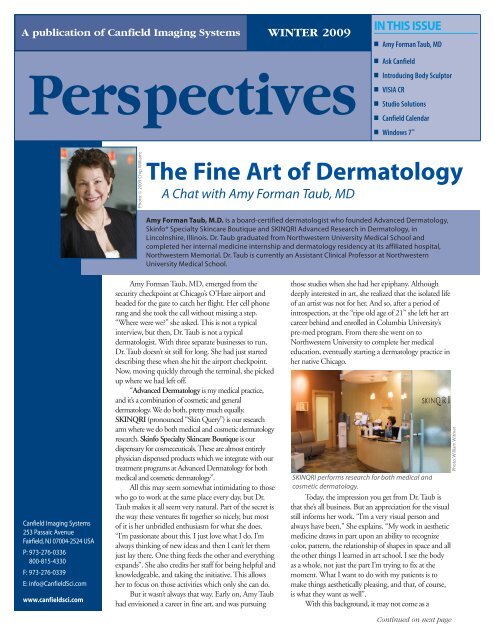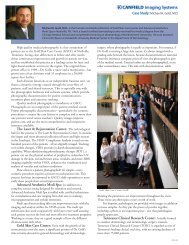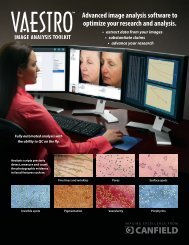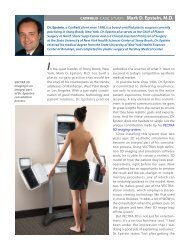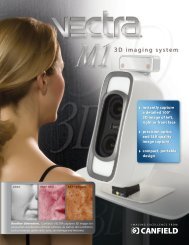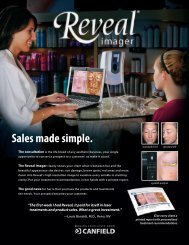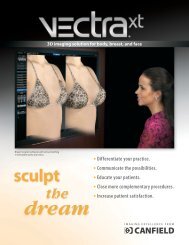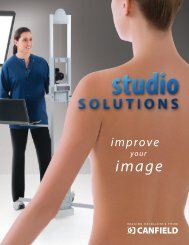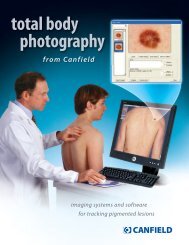Winter 2009 - Canfield Scientific Inc
Winter 2009 - Canfield Scientific Inc
Winter 2009 - Canfield Scientific Inc
- No tags were found...
You also want an ePaper? Increase the reach of your titles
YUMPU automatically turns print PDFs into web optimized ePapers that Google loves.
A publication of <strong>Canfield</strong> Imaging Systems WINTER <strong>2009</strong>PerspectivesIN THIS ISSUE■ Amy Forman Taub, MD■ Ask <strong>Canfield</strong>■ Introducing Body Sculptor■ VISIA CR■ Studio Solutions■ <strong>Canfield</strong> Calendar■ Windows 7 The Fine Art of DermatologyA Chat with Amy Forman Taub, MDAmy Forman Taub, M.D. is a board-certified dermatologist who founded Advanced Dermatology,Skinfo® Specialty Skincare Boutique and SKINQRI Advanced Research in Dermatology, inLincolnshire, Illinois. Dr. Taub graduated from Northwestern University Medical School andcompleted her internal medicine internship and dermatology residency at its affiliated hospital,Northwestern Memorial. Dr. Taub is currently an Assistant Clinical Professor at NorthwesternUniversity Medical School.<strong>Canfield</strong> Imaging Systems253 Passaic AvenueFairfield, NJ 07004-2524 USAP: 973-276-0336800-815-4330F: 973-276-0339E: info@<strong>Canfield</strong>Sci.comwww.canfieldsci.comAmy Forman Taub, MD, emerged from thesecurity checkpoint at Chicago’s O’Hare airport andheaded for the gate to catch her flight. Her cell phonerang and she took the call without missing a step.“Where were we?” she asked. This is not a typicalinterview, but then, Dr. Taub is not a typicaldermatologist. With three separate businesses to run,Dr. Taub doesn’t sit still for long. She had just starteddescribing these when she hit the airport checkpoint.Now, moving quickly through the terminal, she pickedup where we had left off.“Advanced Dermatology is my medical practice,and it’s a combination of cosmetic and generaldermatology. We do both, pretty much equally.SKINQRI (pronounced “Skin Query”) is our researcharm where we do both medical and cosmetic dermatologyresearch. Skinfo Specialty Skincare Boutique is ourdispensary for cosmeceuticals.These are almost entirelyphysician dispensed products which we integrate with ourtreatment programs at Advanced Dermatology for bothmedical and cosmetic dermatology”.All this may seem somewhat intimidating to thosewho go to work at the same place every day, but Dr.Taub makes it all seem very natural. Part of the secret isthe way these ventures fit together so nicely, but mostof it is her unbridled enthusiasm for what she does.“I’m passionate about this. I just love what I do. I’malways thinking of new ideas and then I can’t let themjust lay there. One thing feeds the other and everythingexpands”. She also credits her staff for being helpful andknowledgeable, and taking the initiative. This allowsher to focus on those activities which only she can do.But it wasn’t always that way. Early on, Amy Taubhad envisioned a career in fine art, and was pursuingthose studies when she had her epiphany. Althoughdeeply interested in art, she realized that the isolated lifeof an artist was not for her. And so, after a period ofintrospection, at the “ripe old age of 21” she left her artcareer behind and enrolled in Columbia University’spre-med program. From there she went on toNorthwestern University to complete her medicaleducation, eventually starting a dermatology practice inher native Chicago.Today, the impression you get from Dr. Taub isthat she’s all business. But an appreciation for the visualstill informs her work. “I’m a very visual person andalways have been.” She explains. “My work in aestheticmedicine draws in part upon an ability to recognizecolor, pattern, the relationship of shapes in space and allthe other things I learned in art school. I see the bodyas a whole, not just the part I’m trying to fix at themoment. What I want to do with my patients is tomake things aesthetically pleasing, and that, of course,is what they want as well”.With this background, it may not come as aContinued on next page
surprise that very early on Dr.Taub realized the value of photography in adermatological practice. The first time she saw <strong>Canfield</strong>’s VISIA facialimaging system, she knew it would be a perfect fit to her practice. Soperfect, in fact, that she bought two; a VISIA Complexion AnalysisSystem for her practice, and the clinical research model, a VISIA-CR, forSKINQRI. She has also installed a complete, full body photo studio,powered by <strong>Canfield</strong>’s Mirror Medical Imaging Software. Mirror alsoprovides the image capture and management backbone for the VISIA-CR,and integrates seamlessly with the VISIA Complexion Analysis system.But this is not about pretty pictures. It’s about good medicine, goodpatient communication and good business. Every patient that comes to thepractice is photographed to establish a baseline for treatments. Follow upphoto sessions during the course of treatments are used to objectively trackthe patient’s progress. “Before-andafterphotos are indispensable.Patients don’t always recognize theimprovement because it’s been agradual process over time. MostAskWhy do <strong>Canfield</strong> imagers use cross polarized photography?Two things happen when light from a camera’s flashilluminates a person’s skin. Some of the light is reflected from theskin directly back toward the camera, much as it would be fromany shiny surface. The light reflected in this way provides visualinformation about the skin’s texture, lines, wrinkles and pores.The rest of the light penetrates the skin’s translucent surface andilluminates the underlying tissue. It is the pigmentation andvascular structure within this tissue that determines the skin’sdistinctive coloration and evenness.In a “Standard light” photograph, we see both the surfacereflections and the illuminated sub-surface structure of the skin.However, when a polarizing filter is placed over the flash, andanother one, rotated 90 degrees, is placed over the camera lens,surface reflections are virtually eliminated. This is “CrossPolarized” photography, and it provides an unobstructed view ofthe tissue beneath the skin’s surface.Skin care professionals see a lot in cross polarizedphotography, and it helps guide their consultations and treatmentof sun damage, hyperpigmentation, spider veins, rosacea andpeople are not very objective when they look in a mirror, so with thepictures it becomes something of a teaching moment”.Before she started using photography, Dr.Taub would sometimeshave to offer free procedures to patients who felt that there was not enoughimprovement. Now, patients who see their before-and-after photographsnot only realize how much better they look, but often want to do evenmore. As a result, they book additional procedures, and a patient that camein to correct a single problem becomes aregular customer.Dr. Taub finds photographyeducational for herself as well as herpatients. “I’ve learned so many thingsfrom looking at the pictures. If a frecklehasn’t gone away after photorejuvenation, it could be an actinic keratosis. You can see a lot byexamining pictures taken with different lighting modalities, particularlywith cross polarized images. When I Iook at a patient’s photos it gives mea chance to study what it was that really made the difference. And thathelps me provide better treatments for other people in the future”.At O’Hare Airport, Dr. Taub’s flight departure is called, and shegathers up her belongings to board the plane. Does she have any lastadvice to practices that are considering photography? “Don’t put it off”she states emphatically. “When we first started out it was important tokeep expenses down, so I didn’t buy a photo system right away. I regretthat now because we missed out on a lot. There are just too manyvariables in this business not to photograph a patient. And don’t worryabout photographic expertise. With a system like VISIA, a detailedknowledge of photography is not critical”.With that she boards the plane, and we say goodbye to Amy FormanTaub, MD; dermatologist, scientist, business woman, artist, and the mostenthusiastic advocate of clinical photography that you’re likely to find. •more. For a more powerful visualization, cross polarizedphotographs also provide the basis the RBX image processingemployed in <strong>Canfield</strong>’s VISIA and Reveal Imager. RBX isolatesthe unique red and brown color signatures of hemoglobin(vascularity) and melanin (pigmentation) and generates a clearvisualization of their distribution beneath the skin’s surface. •13“There are just toomany variables inthis business to notphotograph a patient”-Amy Taub, M.D.24
Introducing Body Sculptor 3D SimulationExpanding the highly acclaimed Sculptor 3D software line,<strong>Canfield</strong>’s newest release provides photo-realistic, three dimensionalsimulations of the most widely requested body contouring andaugmentation procedures. Like the well established Face Sculptorand Breast Sculptor modules, Body Sculptor begins with a highresolution 3D photograph of the patient taken with the VECTRAimaging system. Then, using powerful and intuitive softwareinterface, the practitioner can quickly modify the image to simulatethe desired post operative outcome. Body Sculptor will include all ofthe breast augmentation tools previously delivered in the BreastSculptor module, which it replaces.With annul billings of about 1.3 billion a year, body contouringhas become one of the fastest growing areas of aesthetic medicine,motivated in part by the development of new, non-invasive procedures.These procedures, along with the more traditional surgical approachessuch as augmentation, abdominoplasty and liposuction, can besimulated using Body Sculptor software. This provides anextraordinary patient consultation tool, particularly when there is theoption to perform multiple, complementary procedures, as in thepopular “Mommy Makeover”.Because Body Sculptor simulations show outcomes using thepatient’s own anatomy, a great deal of the uncertainty about theresult is removed. This provides prospective patients with theBody Sculptor provides photo-realistic, three-dimensionalsimulations of the leading cosmetic proceduresProcedure Annual Rate RankSurgicalBreast Augmentation 307,000 1Rhinoplasty 279,000 2Liposuction 245,000 3Tummy Tuck 122,000 5Minimally InvasiveBotox ® 5,000,000 1Hyaluronic Acid 1,100,000 2Chemical Peel 1,000,000 3Microdermabrasion 842,000 5Source: ASPS – <strong>2009</strong> Report of Plastic Surgery Statisticspre-op3D imagesimulatedbreastaugmentationconfidence to commit to the procedures, shortening the decisionprocess and increasing conversion rates. And because the patient’sexpectations have been clearly established, they are far more likely tobe satisfied with the results.The development of Sculptor software has transformed aestheticpractices worldwide. VECTRA’s three-dimensional photographs canbe rotated to provide multiple views of the simulated outcome, sideby side or overlaid on the pre operative pictures. Breast augmentationcandidates no longer need to make a decision based on someoneelse’s photographs or by stuffing bras, resulting in a morecomfortable, and productive, consultation session. And with thesimple installation of a flat panel display inthe operating room, the simulated imagescan be used as a guide during surgery.In addition to the clear medical value,there is a significant “Wow!” factor inVECTRA 3D powered consultations. Oneuser, Dr. Jason Pozner, Medical Director ofSanctuary Plastic Surgery in Boca Raton,Florida, explains “Patients like it. It’s notadd atummy tuckfor “mommymakeover”“If your patients areconsidering aestheticprocedures, this is thetechnology theyshould be looking for”-Jason Pozner, M.D.gimmicky, it looks cool and the process is easy. You don’t have to takea lot of photos, so it’s a real time saver. Just one shot and it’s over. Weactually don’t take that many 2D pictures anymore”. Not only doesthis translate to improved patient satisfaction, it increases referrals aswell. “If your patients are considering aesthetic procedures, this is thetechnology they should be looking for.” •<strong>Canfield</strong> Awarded Patent for VISIA-CRThe patentedVISIA-CR imaging techniques combine optical science, and light-tissueinteraction to take standard digital photography to a entirely new level of tissue characteristicspecificimaging.Multi-source programmable and dynamically-configurable lighting allow shaping thelighting environment to enhance a specific surface or sub-surface skin feature like wrinklesand fine lines, pores, pigmentation, vascular structure, dryness and many more, in thecaptured image sequence.Spectral and modal mixing, optimal placement of sources, directional lighting, meteredintensity control, and, sequential firing of multiple light sources during a single exposure are allprogrammed into feature specific image capture templates.This technology together with the<strong>Canfield</strong>'s Image Analysis Suite provides a complete analysis solution for clinical trial applications.
WEBINARSTRADE SHOWSof eventsDate Event Time (EST) / Location12/15/09 VISIA Medispa Solution 12:00 pm12/16/09 Reveal 3:00 pm12/17/09 VISIA Medispa Solution 3:00 pm12/18/09 Sculptor 3D 3:00 pm01/05/10 PhotoFile & PhotoTools 3:00 pm01/07/10 Simulation & Suite 3:00 pm01/12/10 VISIA Medispa Solution 12:00 pm01/13/10 Sculptor 3D 12:00 pm01/14/10 VISIA Medispa Solution 3:00 pm01/20/10 Reveal 12:00 pm02/02/10 PhotoFile & PhotoTools 12:00 pm02/04/10 Simulation & Suite 12:00 pm02/09/10 VISIA Medispa Solution 12:00 pm02/11/10 VISIA Medispa Solution 3:00 pm02/17/10 Reveal 3:00 pm02/24/10 Sculptor 3D 12:00 pm12/10/09-12/12/09 IMCAS Annual Meeting Paris, France01/08/10-01/11/10 AACS Annual <strong>Scientific</strong> Orlando, FL02/11/10-02/13/10 Baker Gordon Symposium Miami, FL03/05/10-03/09-10 AAD Annual Conference Miami, FL03/25/10-03/26/10 3D FIRG Netherlands04/13/10-04/15/10 In-Cosmetics Paris, France04/14/10-04/18/10 ASLMS Phoenix, AZ<strong>Canfield</strong> Software compatible with Windows® 7 Current versions of VISIA, Reveal and Mirror imagingsoftware are fully compatible with Windows 7 ® Ultimate andProfessional editions (not the Home edition). As a generalrule, if your <strong>Canfield</strong> software is running well on WindowsXP ® or Windows Vista ® there is no need to upgrade toWindows 7 ® . If you are planning to purchase a new computerwith Windows 7 ® Ultimate or Professional, please contact<strong>Canfield</strong> first at 800-815-4330 or by email atTechSupport@<strong>Canfield</strong>Sci.com to ensure that you have thelatest version of your imaging software. As always, softwareupgrades are provided at no charge to customers with currentSupport and Upgrade agreements. If you are currentlyrunning Mirror or VISIA software on Windows XP ® with anolder camera or VISIA booth, please contact <strong>Canfield</strong> to makesure your capture device is compatible with Windows 7 ® .Studio SolutionsPhotography today is so easythat, literally, a child could doit. And while you probablywouldn’t use a Lego ® themedcamera in your practice, thereare many options available fromsimple Point-and-Shoot (PAS) models to sophisticatedSingle Lens Reflex (SLR) systems. All of these camerasfeature a built in flash which can fire automatically whenneeded. Although that may seem convenient, it is seldomthe best solution for clinical photography.Lighting is perhaps the most critical factor inphotography for aesthetic practitioners. It can make thedifference between an excellent photograph and one that isworthless. The good news is that it’s relatively easy toachieve good lighting using external flash units positionedto provide the right level and angle of illumination.Cameras used with external flash must provide a) themeans to trigger the flash, usually through a “hot shoe”adapter, and b) manual control of exposure. <strong>Canfield</strong>offers a variety of both PAS and SLR cameras that havebeen selected for this purpose.For a simple yet effective integrated solution, the<strong>Canfield</strong> IntelliStudio ® combines lighting and camerapositioning in a single mobile device. Three calibrated andcolor balanced IntelliFlash units move vertically with thecamera mount to assure perfect lighting from any position.Two high-powered main lights arepositioned well above the camera toprovide strong cross-illuminationof the subject’s surface, while alower powered fill light justbelow the lens axis renders detailin the shadow areas.Designed with the aestheticpractice in mind, this geometryreveals body contour and surfacestructure, as well as subtle variationsof skin color and tone. Built inranging lights assure perfect camerato-subjectdistance every time. Apatient positioning mat andprofessional blue backdrop areincluded to assure precise, repeatablepositioning and a uniform,distraction free background. TheIntelliStudio can be configured asa complete turnkey imagingcenter, complete with camera,lights, adjustable camera mount,a laptop computer and Mirror ®imaging software.


